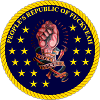I was wondering that too. not ahving point defense weapons "Sort of" makes sense if your shields can repel physical objects. you are putting the resources into the shield isntead of the little turrets. Also if you are running around the universe telling people you are on a peaceful mission, it helps to not have extra turrets hanging around.ray245 wrote:So given the fact that physical objects can wreck the hull of the Enterprise, does that mean a simple slug shot at any federation ship is enough to destroy it?
In this Trek, they HAVE point efenses, and we SEE physical objects damaging the hull when the shields are stated to be up. you can't even pretend the shields rob inertia, are keyed to objects moving at "harmful speed" (Dune, SG-1) and there isn't evidence of different "kinds" of shields. (SW specified "Ray shields" implying there would be some other kind).
On the other hand there was the comment shouted on board the kelvin "Are our shields even up??" implying the expected the shields to help them against the missiles being thrown at them.
Maybe the shields are "more" effective against energy weapons (No evidence though, ahve we even seen energy weapons fired at a federation ship yet?) but offer some degree of protection against small physical objects? "Advanced" torpedoes might plow through shields because they are built of futuristic tough materials, or propelled faster than the shields can account for. if Abrahms returned to the concept of "Deflector screens" instead what evolved into a protective bubble, that could mean the "Shields" are just projected energy that objects can float around, or even crash through with more force than is applied to the deflector screen. or the narada's missiles could just detect deflector screens and fly around them. The point defense turrets could act as a a back up system.
Even if the federation KNOWS the klingon ships ahve a single thermal exhaust port just over two meters wide, it would be crazy to think you hit it on multiple targets with one shot apiece, even if their shields were down, because even if they have no shields, they could move out of the way, or possibly use PDL of their own right?Jason L. Miles wrote: Also, the weapons officer seemed a little taken aback by the order, as if Kirk's confidence that "one should be enough" was crazy.
Were the bones referring LITERALLY to his bones? I thought he raised the flask, doe that mean Bones are his term for booze and McCoy is being called in essence "Lushy"?Crazedwraith wrote:Perhaps not an explicit difference but I think in TOS, McCoy is called Bones because its a nickname for Doctors (sawbones) whereas in the film we see its from McCoy complaining "The Wife took the whole damn planet; all I got is my bones"
Wasn't it a "big deal" in STIII that Scotty automated a constitution class to be run from the bridge with three people? Even if George was telling the Kelvin what to do and handling the "Strategy" just doing things like regulating propulsion, sensors and whatnot, implies a higher degree of computer automation than was used in TOS. but the crews are bigger?? What do all of those people do besides run around in the hallway and leave huge sections of engineering unattended while people swim around in water tubes with Ensign Darwin.Ted C wrote:The M5 was capable of advanced tactical and strategic decision making. In the combat sim, it decided when to initiate combat, course and speed for best approach to its targets, prioritized targets, and actually fired the weapons. It decided when to press the attack and when to retreat. It was basically acting as both captain and crew for the ship.erik_t wrote:Let me rephrase. What was so impressive from a combat standpoint? Wikipedia would have me believe that it was much more capable in the combat simulations than a manned ship. This shouldn't surprise anyone if there was an autopilot which seemed perfectly combat-capable a generation earlier.



